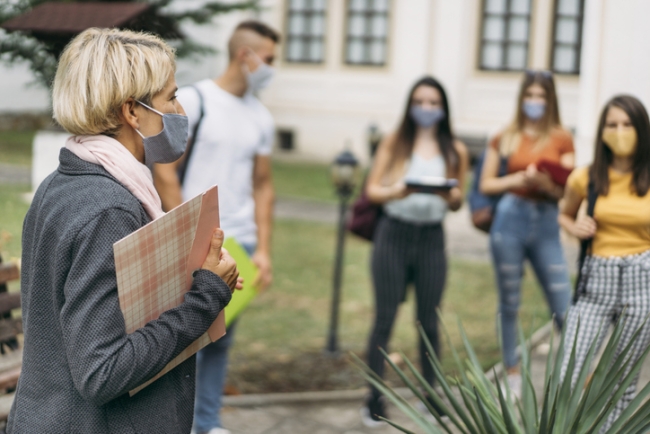You have /5 articles left.
Sign up for a free account or log in.

Vladimir Vladimirov via Getty Images
A new survey of college presidents by the American Council on Education offers a window into the leaders' continued concerns about the pandemic’s “dire” economic impact on their institutions and the higher ed priorities they are hoping to see in the Biden administration.
ACE surveyed 268 college presidents between Nov. 10 and 17, the majority of whom lead private four-year institutions (44 percent) and characterized their college as “primarily residential” (42 percent). It was the second of two surveys of presidents conducted during the fall semester. Jonathan Turk, director of research and co-author of the ACE president surveys, said the mental health of students, faculty and staff members and the financial health of institutions are the major concern for college leaders as the fall semester concludes.
Sixty-eight percent of the presidents ranked student mental health as a “pressing” issue that surpassed other concerns such as the “financial viability” of their institutions, the survey report said. The proportion of college presidents (60 percent) who named faculty and staff mental health as a top issue also rose; it was ranked second in the latest survey after being ranked third in September. Turk said faculty and staff mental health has been among presidents’ greatest concerns throughout the pandemic.
“We’ve been asking the ‘top of mind’ question since April, and the mental health of students and faculty and staff have been consistent,” Turk said. “We weren’t surprised about that.”
Two-thirds of the presidents said they have seen the use of campus or teletherapy mental health services rise due to the pandemic, and public four-year institutions were most likely to see increased utilization, the report said. Teletherapy or telepsychiatry, which are methods of administering mental health counseling or a psychiatric doctor visit via video or phone conferencing, were the most popular mental health support strategies implemented in response to the effects of the pandemic, with 59 percent of presidents reporting that their institutions invested in the virtual services.
Access to these services and to counselors and other care providers was identified by young people as one of the best ways to improve their mental health outcomes, according to a recent survey conducted by Mental Health America, a national mental health advocacy organization. Fifty-seven percent of the 19- to 24-year-olds surveyed by MHA in November said the ability to access mental health care providers is among the “most helpful” ways to improve their mental health, the report said.
However, 45 percent of 19- to 24-year-olds also said that “mental health breaks or absences” from classes or work is of top importance, the MHA report said. The pandemic has led to the elimination of midsemester breaks at many institutions. According to the ACE survey of presidents, 40 percent said their institutions plan to eliminate spring break in 2021 as a result of the pandemic.
Kelly Davis, director of peer advocacy supports and services and author of the MHA report, said in an email that colleges should incorporate breaks into the semester and professors should be lenient about absences from class in order to make up for the lost downtime.
“Students are dealing with intense challenges, and many are isolated, overwhelmed and disengaged from virtual learning,” Davis said. “Breaks provide an important space for students to relax … If colleges are not providing campuswide breaks, they should work to build breaks elsewhere, whether that is through agreed-upon days during the semester or flexibility in attendance requirements and deadlines for students.”
In general, the ACE survey found that presidents are continuing to use the same mode of instruction used during the fall semester in spring 2021, Turk said. For example, 55 percent of presidents responded that their institutions will be “predominantly online, with some in-person instruction” during the spring, nearly the same number (54 percent) that pursued this model during the fall. One notable difference was a 6 percent decline in the number of presidents who said their institutions would offer classes exclusively online in spring 2021; the number fell from 8 percent in fall 2020 to 2 percent for the upcoming semester, according to the survey report.
About three-quarters of presidents of public two-year colleges said they are offering “predominantly online” instruction, and these colleges also experienced greater enrollment declines between fall 2019 and fall 2020 than other types of institutions, Turk said. More than half of these presidents reported that they saw a 6 to 10 percent enrollment drop, compared to only 37 percent of public four-year institutions and 30 percent of private four-years that had a decline within that range, the report said.
The financial situation of community colleges during the pandemic has proven to be “much more dire” than other sectors', Turk said. Presidents over all expressed a pessimistic outlook of their colleges’ finances going into 2021, the report said. While 58 percent of presidents rated their institutions’ general financial health as “excellent” or “good” for fall 2020, this dropped to 48 percent when asked about fall 2021, the report said. About 15 percent of presidents described their college as “below average” or “failing” financially for both years.
Perhaps unsurprisingly given the financial state of their institutions, a majority of presidents (79 percent) marked additional congressional COVID-19 relief for colleges as a “high priority” for the incoming Biden administration, the report said. Ninety-five percent of college presidents also said increasing need-based student financial aid was a “high” or “moderate priority” initiative for President-elect Joe Biden, which could include policies such as a free college program or expanding Pell Grants, Turk said.
“It’s clear that presidents think there should be a greater focus on student aid,” he said.




